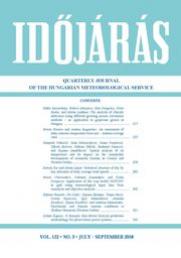IDŐJÁRÁS - angol nyelvű folyóirat
Vol. 122, No. 3 * Pages 217–361 * July - September 2018
 |
|
 letöltés [pdf: 4424 KB]
letöltés [pdf: 4424 KB]
Statistical structure of day by day alteration of daily average wind speeds
Károly Tar and István Lázár
DOI:10.28974/idojaras.2018.3.4 (p. 285–)
Károly Tar and István Lázár
DOI:10.28974/idojaras.2018.3.4 (p. 285–)
IDŐJÁRÁS folyóirat

Az IDŐJÁRÁS a HungaroMet Nonprofit Zrt. negyedévenként megjelenő angol nyelvű folyóirata
Megrendelhető a journal.idojaras@met.hu címen.
A szerzőknek szánt útmutató itt olvasható.
Megrendelhető a journal.idojaras@met.hu címen.
A szerzőknek szánt útmutató itt olvasható.









